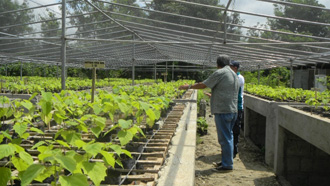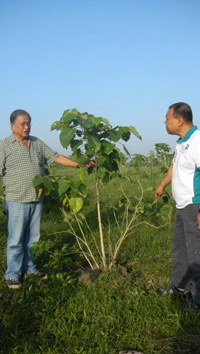 Super typhoon Lawin, which hit Isabela in October 2016, badly affected the projects on yemane (Gmelina arborea Roxb.), a wood tree species.
Super typhoon Lawin, which hit Isabela in October 2016, badly affected the projects on yemane (Gmelina arborea Roxb.), a wood tree species.
Titled “Juvenile Variations in Forest Genetic Materials of Seedlings of Falcata and Yemane” and “Advancement of Science for the Sustainable Utilization and Conservation of Forest Genetic Resources of Falcata and Yemane,” both projects are funded by the Philippine Council for Agriculture, Aquatic and Natural Resources Research and Development of the Department of Science and Technology (DOST-PCAARRD).
The projects aim to generate more information on falcata and yemane’s genetic and observable characteristics to determine the tree species with the best genetic material.
To check whether the projects were able to recover from the super typhoon, Dr. Marcelino U. Siladan, Industry Strategic S&T Program (ISP) Manager for Rubber and Industrial Tree Plantations, visited the project sites at Isabela State University (ISU), particularly at its Cabagan and Echague campuses.
 Yemane and falcata (Paraserianthes falcataria (L) Nielsen) are fast-growing wood tree species. Yemane wood can be used as construction materials, particularly for furniture and joinery, while falcata wood can be processed into paper, veneers, and crates.
Yemane and falcata (Paraserianthes falcataria (L) Nielsen) are fast-growing wood tree species. Yemane wood can be used as construction materials, particularly for furniture and joinery, while falcata wood can be processed into paper, veneers, and crates.
The yemane project is based at ISU, where yemane tree species are abundant, while the falcata project is based at Central Mindanao University in Bukidnon.
During the ocular visit, Dr. Edmundo C. Gumpal, Dean of the College of Forestry and Environmental Management in ISU Cabagan campus, discussed the problems encountered as well as the catch up strategies done on the project.
“The nursery structure for the Juvenile Project was toppled down, but we were able to immediately rebuild it and raise the seedlings on time,” Gumpal said.
The yemane seedlings in the field trial sites in ISU Echague and Cabagan remained in their seedling stage (less than 1.2 m in height and less than 7 cm in diameter at breast height), an evident effect of the super typhoon. They also produced coppice or sprouts. Experts explain that yemane produces coppice or shoots when it is cut or subjected to stress.
Based from the field visit, project implementers recommended cutting of coppice/sprouts and leaving a dominant leader as basis in determining the best seed lot or mother tree; and establishing a third site near the College of Forestry and Environmental Management for easy monitoring, supervision and control.
